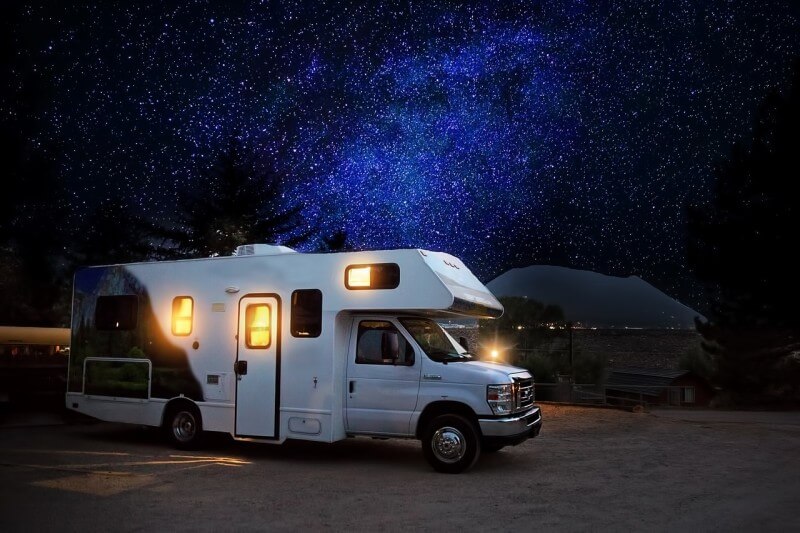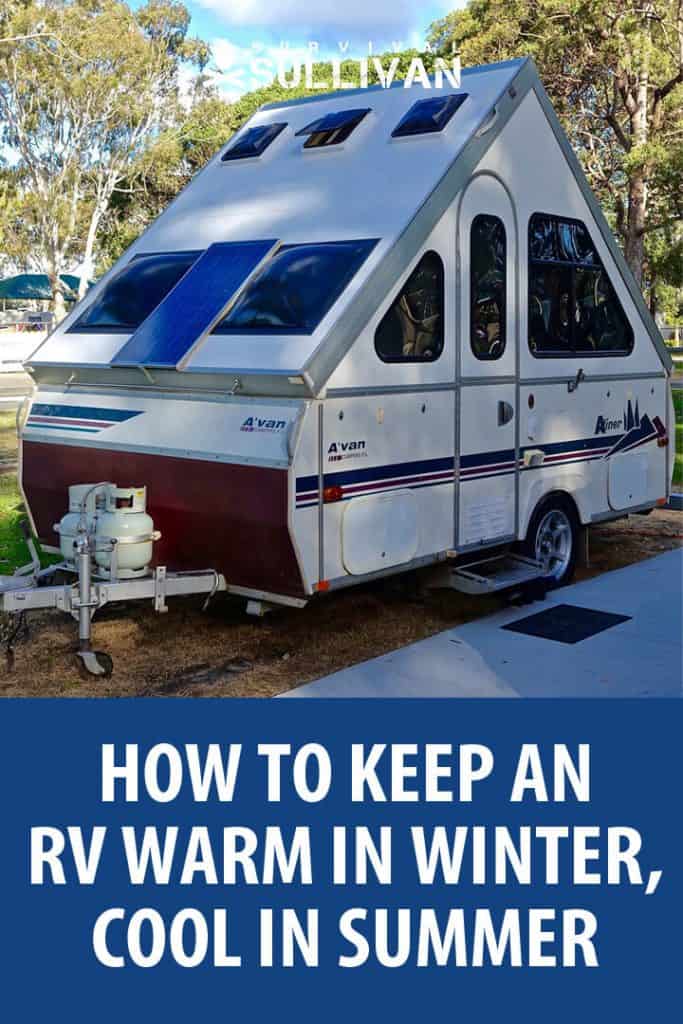More and more people are hitting the open road in an RV, whether part-time for a short ski trip or Disney vacation or as a full time lifestyle change with the bonus of traveling wherever the mood strikes. Some are even considering bugging out in one.
The increase in extended RV travel means more people are trying to figure out how to keep an RV warm in winter and cool in summer weather. Keep reading for some of our best tips to make your trip comfortable no matter what the weather.

Tips to Keep Your RV Warm in Winter
Start with the Right RV
The best cold weather RVs are designed to operate in below freezing weather, prepped to withstand snowy conditions and icy winds.
If using your RV in extreme cold weather, try to get an RV that comes equipped with an Arctic package or kit, which includes heating elements and insulation to keep you and your family warm in colder weather.
Depending on the budget you have, you can purchase RVs that come with a variety of different features designed to keep you warm including:
- thermo pane windows
- RV wide insulation
- An insulated underbelly that is heated to keep things from freezing
- Electronically-controlled heated holding tanks
- Fireplace upgrade
- Heated Master Bedroom mattress
- R-14 upper deck flooring insulation
- R-15 equivalent slide out floors
- R-34 roofing insulation values
- R-21 or R-38 main floor insulation
- Four season foam insulation
Some of the Best Rated Cold Weather RVs and Off-Grid Trailers Include:
- Keystone Raptor
- Heartland Bighorn
- Lance 4 Seasons Travel Trailer
- Forest River Arctic Wolf
Okay so, ideally you want to choose an RV that is best rated for cold weather, but what if your budget doesn’t allow for that type of luxury?
What else can you do to keep an RV warm in winter and cool in summer? We’ve rounded up some tips from people who have braved the cold weather in all types of RVs, including the lemons, and here’s what they suggest:
Keep the Area Under Your RV Warm
The area under your RV is home to various pipes and valves that you don’t want to freeze. When your RV is open to the elements all the way around the bottom, this can also allow cold air to get up under the RV and seep inside through your floors, Keep the area under your RV warm and it will help to keep your RV warm in cold weather.
- Attach skirting or use hay or straw bales.
- Insulate baggage doors to prevent air from getting through to the underbelly
- If your RV will be stationary through the winter, you can pile up snow against the skirting around your RV to act as an additional insulator around the bottom of your RV.
- If necessary, add a portable heater on really cold days or nights.
Use Renewable Resources
Use passive solar heat from sun to keep things warm. You can do this by letting sunlight into your RV during the day and then closing blinds and covering windows at night to hold the heat.
You can also use the power of sunlight to heat your RV by facing your largest windows to the South where they will get the sunlight for most of the day.
If your budget allows, you can install solar panels on the roof of your RV to provide power to a battery bank you can then use to heat your RV or use a portable solar panel that you setup and use to charge your battery bank whenever you stop.
Choose the Right Heaters
Most RVs designed for winter weather will come with a furnace. These generally require electricity to run the ignition and fan, and propane to operate.
In cold weather, a furnace that comes on and runs off and on trying to keep the RV warm can deplete your battery bank quickly. For this reason, experienced winter campers opt for alternative heating options such as those below:
Catalytic heater uses no power and minimal propane. Has low, medium, and high settings. Will keep the RV space warm for hours in colder climates. The furnace in an RV uses power and quite a bit of propane. Upgrading to the catalytic heater keeps RV warmer when no power is available.
Oil heaters can really help to keep your RV warm, especially on cold days and nights. They do require electricity to operate, but they do not give off any dangerous fumes. Oil heaters radiate very warm heat and are great for small spaces. Be sure to get one with a safety tip over shut off switch.
Disclosure: This post has links to 3rd party websites, so I may get a commission if you buy through those links. Survival Sullivan is a participant in the Amazon Services LLC Associates Program. As an Amazon Associate, I earn from qualifying purchases. See my full disclosure for more.
Parabolic heaters are designed with a deflection plate that diffuses the heat into several different directions. Most parabolic heaters are also extremely energy efficient which makes them great for RV’s if you have power available.
CAUTIONS:
- Be careful of fumes getting into trailer or oxygen being sucked out of the trailer when using alternative heating sources in a small enclosed space.
- Always use a CO detector with an audible alarm any time you are operating a heater in an RV.
- Use a dehumidifier to prevent moisture buildup from condensation and keep mold and mildew from growing.
Insulate Wherever Possible
- Foam insulation boards work well inside of cabinet doors or even on the inside of storage doors underneath or outside of your RV.
- You can use bubble wrap directly on windows, then pull the blinds, and cover with a fleece blanket and/or a thermal backed curtain.
- For the large driver’s windshield, use a reflective insulated covering. You can pick these up at any local Walmart and they are relatively inexpensive. The reflective surface will attract heat and the insulation will help retain the heat inside your RV.
- If you will be stationary for several hours or overnight, close off the truck cab of your RV and the entry doors from the rest of the unit to help prevent heat loss. Make sure to install weather stripping around all entry doors to prevent heat loss.
- Add thick layers of cardboard underneath your bed mattresses as an extra insulative layer from the cold and condensation.
- RV floors can be drafty, especially if you tore up the carpet and replaced with laminate flooring. Use throw rugs to insulate the floors, especially along the seams where the floors meet the walls. As we mentioned above, block off and insulate the underside of your RV with a skirt to keep cold air from making floors colder.
Keep Air From Blowing In
- Install vent covers over the outside of any vents so you can open them if needed for circulation without cold air rushing inside. From the inside, you can purchase insulated vent covers or make your own from foam panels cut to size.
- Install a slide topper to keep ice and snow from building up on the roof of your slide out. Whenever possible, close slides that aren’t being used to prevent drafts.
- If windows don’t seal tightly because they are old or warped, tape them closed using HVAC aluminum tape and plastic to seal everything up.
Keeping an RV Warm for Sleeping
Boil water and fill an old fashioned silicone hot water bottle. Slide it under the sheets near your feet when you get into bed. This really helps keep your feet and legs warm when sleeping on cold nights.
Invest in a sleep cap that is made of cotton or wool and will help keep your head and ears warm while you sleep. If your head is near a window when sleeping, pile extra pillows against the window for additional insulation.
Use Layers On Your Bed
Most winter campers know that getting into a cold bed can be a pain at the end of a long day. Use layers on your bed to help keep yourself warm while you’re sleeping on those cold nights. Flannel sheets are best for winter sleeping. Add several warm blankets and at least one thick down comforter to stay nice and toasty all night long.
Dress Yourself in Layers Too
One of the best ways to stay warm in winter is obviously to wear layers. If you get in the habit of wearing layers, you can take them off or put them on to keep your body temperature regulated without having to crank up the heat or the A/C.
Lightweight nylon or fleece makes a good outer layer. Use a wicking layer against the skin and then cotton in the summer or wool in the winter.
Prevent Freezing
Wrap pipes in foam insulation and/or use a heat cable on water hose supply line if you have power. Insulate the compartment which holds your hot water tank and if really cold use a indoor safe portable heater with tip over safety switch and thermostat.
Some RVers use light bulbs to give off heat in small areas like where your water hose connects to your RV, just make sure they’re mounted safely. If feasible, you can duct some of your RV heat from the furnace into the hot water tank bay area to keep things from freezing.
If using campground hookups, you can also add extra insulation to the spiquot from the incoming RV water supply to your RV connection to help keep it from freezing.
Don’t let any of your tanks get full.
Keep fresh water tank at ¼ full if it’s not heated, so if it does freeze it can expand and won’t break. Grey and black water tanks should be emptied if you are expecting cold weather.
Protect pipes and valves underneath your RV to grey and black water tanks to prevent breakage. You can use a heat cable and insulation or buy a special insulated sleeve meant to fit over the pipe valves.
If you will be cold weather camping for an extended period of time, you can use antifreeze in your black water and grey water holding tanks to keep them from freezing.
Leech water in your lines at night or just before cold snap
When you’re expecting below freezing temperatures at night or just before a cold snap, you can leech water from your lines and pipes so if they do freeze, they won’t break.
Fill an extra jug or two with water before you leech your lines so that you do have extra if the water freezes. Then turn your water pump off and turn faucets on to empty water out of the lines. With the water pump still off, flush the toilet to empty that too. You may wake to frozen water but at least nothing should break and it will work again once it thaws.
Okay so, now that you know how to keep an RV warm in winter, what about keeping an RV cool in summer when temperatures can soar well above 90 degrees Fahrenheit?
How to Keep an RV Cool in Summer
The good news is that quite a few of the things that we listed for how to keep an RV warm in winter will also come into play to keep it cool in the summer. This is especially true with the insulation ideas we mentioned.
Protection from the Sun
- Experienced RVers agree that one of the best ways to keep an RV cool in summer is to pay attention to how you park your unit. Park so that your largest windows and/or your refrigerator and A/C vents are in the shade for the better part of the day.
- Cover the roof of your RV with a tarp or if in a semi-permanent location, build a roof over your RV parking spot.
- It’s also a good idea to cover the windows and any skylights to keep direct sunlight out. If your budget allows, you can apply tinting to windows to help keep sunlight out.
- Make sure your RV A/C unit is running smoothly and efficiently. Use an Evaporative Air Cooler, portable air conditioner cooler, or a bedroom A/C unit. Some campers have had success using basement (underside) air conditioners and then removing a roof vent and install a roof air conditioner.
- Cook outdoors on either a BBQ grill, firepit, or in an outdoor kitchen.
- Ventilate to make sure that air circulation is sufficient to keep things cool.
- Switch to LED Lighting which doesn’t output as much heat as incandescent bulbs do. You’ll be amazed at how much difference this can make.
Catch the Breeze or Create It
Open the windows to let fresh air in whenever the breeze is blowing. Open windows and let cool night air into the RV in the evening and close windows first thing in the morning to keep warm air out.
On days without a natural breeze, use portable fans wherever it makes sense to keep the RV cool. Always follow manufacturer instructions as far as cleaning and power use.
Keep Yourself Cool
If you’ve done all you can to keep your RV cool in summer and the heat is still getting to you, do what you can to keep yourself cool. Some great ways to lower your body temperature and stay cool include:
- Head to the Pool
- Stay hydrated
- Keep cold drinks on hand
- Use Sunscreen and Sunhat
What are the best way you’ve found to keep your RV warm in winter and cool in summer? Did it make our lists above? Share your ideas and experience with us in the comments below.


Born and raised in NE Ohio, with early memories that include grandpa teaching her to bait a hook and watching her mom, aunts, and grandmothers garden, sew, and can food, Megan is a true farm girl at heart.
For Megan, the 2003 blackout, the events of 911, and the increasing frequency of natural disasters like Hurricane Katrina, spurred a desire to be more prepared. Soon to be living off-grid, this mother of four and grandmother of ten is learning everything she can about preparedness, survival, and homesteading.
